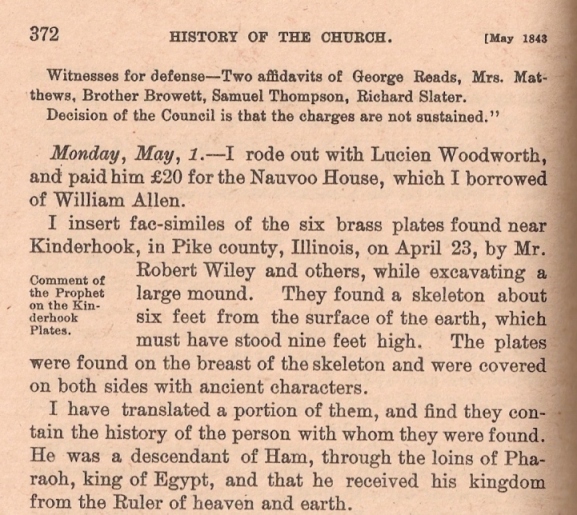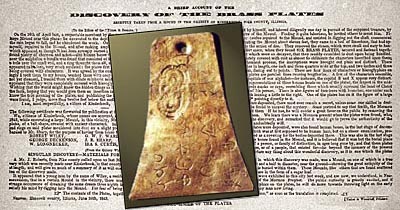Testimony vs. false witnesses – A simple Kinderhook question
Posted: Fri Mar 04, 2011 12:18 am
I'd like to address this to Dr. Peterson, Wade Englund, Benjamin McGuire and Wiki Wonka, but I'd appreciate an answer from any TBM who chooses to answer the question asked.
It’s common knowledge that in Mormon churches people bear their testimony starting out with, “I know the church is true…” While they may believe the church is true, they clearly don’t “know” it’s true. The power of suggestion and community is its purpose, as those who feel the burning in the bosom and share it with others, but the question I’m asking is in this thread deals with the false witness, or those who say the words but don’t actually mean them… are they breaking the 9th commandment?
Consider the following:
http://atheism.about.com/od/tencommandm ... ment09.htm
Semantics of what constitutes a neighbor aside, the definition of a false witness is someone who knowingly states something false under the pretense that they believe it’s true. I’ve debated Mormons on the internet for a few years now and believe I know when they’re making an argument based upon winning the debate rather than coming to the conclusion of what’s actually true vs. false. The two main points of contention in my opinion, is the Kinderhook plate translation and the Book of Mormon translation method. Dr. Peterson fully admitted the use of seer stones in this thread ( viewtopic.php?f=3&t=11896&start=21 ) which I found most admirable.
Regarding the Kinderhook plate translation however, I haven’t found a single TBM willing to acknowledge the truth regarding who said the words about who the descendant of Ham was. Some facts:
How Mormon history reads:
http://www.mormonthink.com/kinderhookweb.htm

The main point brought out by pro-Mormon websites is the use of “I” instead of “President J.” as written by William Clayton. William Clayton’s journal is where these words come from, and a close friend of Joseph Smith he was his primary scribe. It wasn’t uncommon for William Clayton to use “President” when referring to Brigham Young or Joseph Smith, so logic would dictate that when William Clayton used “President J.” he was referring to Joseph Smith.
From the Fair website:
http://en.fairmormon.org/Forgeries_rela ... ook_Plates
In the above, how can one conclude, “Where the ideas written by William Clayton originated is unknown” based on the fact that William Clayton is the one who wrote it down when quoting Joseph Smith? There is no doubt whatsoever that Joseph Smith made that translation in my opinion, but layers of extra data piled on top of this fact is hardly a foundation for making this conclusion, unless one attempts to paint William Clayton as an evil-doer.
To Wade Englund: This link is broken. Is it posted somewhere else? http://www.fairlds.org/apol/ai026.html
My question to you all, is who said these words written down in William Clayton’s journal on May 1, 1843 regarding the translation of the plates referencing the descendant of Ham?
http://www.boap.org/LDS/Early-Saints/clayton-diaries
Thanks
It’s common knowledge that in Mormon churches people bear their testimony starting out with, “I know the church is true…” While they may believe the church is true, they clearly don’t “know” it’s true. The power of suggestion and community is its purpose, as those who feel the burning in the bosom and share it with others, but the question I’m asking is in this thread deals with the false witness, or those who say the words but don’t actually mean them… are they breaking the 9th commandment?
Consider the following:
http://atheism.about.com/od/tencommandm ... ment09.htm
This commandment is somewhat unusual: whereas other commandments probably had shorter versions that were later added to, this one has a slightly longer format that tends to be shortened. Most of the time when people cite it or list it, they use only the first six words: Thou shalt not bear false witness.
Leaving off the ending, “against thy neighbor” isn’t necessarily a problem, but it does avoid difficult questions about just who qualifies as one’s “neighbor” and who doesn’t. One might, for example, plausibly argue that only one’s kinsmen, co-religionists, or fellow countrymen qualify as “neighbors,” thus justifying “bearing false witness” against non-relatives, people of a different religion, people of a different nation, or people of a different ethnicity.
Semantics of what constitutes a neighbor aside, the definition of a false witness is someone who knowingly states something false under the pretense that they believe it’s true. I’ve debated Mormons on the internet for a few years now and believe I know when they’re making an argument based upon winning the debate rather than coming to the conclusion of what’s actually true vs. false. The two main points of contention in my opinion, is the Kinderhook plate translation and the Book of Mormon translation method. Dr. Peterson fully admitted the use of seer stones in this thread ( viewtopic.php?f=3&t=11896&start=21 ) which I found most admirable.
Regarding the Kinderhook plate translation however, I haven’t found a single TBM willing to acknowledge the truth regarding who said the words about who the descendant of Ham was. Some facts:
How Mormon history reads:
http://www.mormonthink.com/kinderhookweb.htm
"I insert fac-similes of the six brass plates found near Kinderhook... I have translated a portion of them, and find they contain the history of the person with whom they were found. He was a descendant of Ham, through the loins of Pharaoh, King of Egypt, and that he received his Kingdom from the ruler of heaven and earth."
Prophet Joseph Smith, Jr., History of the Church, v. 5, p. 372

The main point brought out by pro-Mormon websites is the use of “I” instead of “President J.” as written by William Clayton. William Clayton’s journal is where these words come from, and a close friend of Joseph Smith he was his primary scribe. It wasn’t uncommon for William Clayton to use “President” when referring to Brigham Young or Joseph Smith, so logic would dictate that when William Clayton used “President J.” he was referring to Joseph Smith.
From the Fair website:
http://en.fairmormon.org/Forgeries_rela ... ook_Plates
William Clayton's journal entry becomes Joseph's first-person account
Some critics have tried to show that Joseph did actually attempt to translate the Kinderhook Plates, based on a passage in the History of the Church that was supposedly written by Joseph himself:
I insert fac-similes of the six brass plates found near Kinderhook... I have translated a portion of them, and find they contain the history of the person with whom they were found. He was a descendant of Ham, through the loins of Pharaoh, King of Egypt, and that he received his Kingdom from the ruler of heaven and earth.[6]
However, this account of Joseph translating the plates was not written by Joseph, but is the work of an editor who, following Joseph's death, reworked William Clayton's journal entry and wrote it as if Joseph Smith had spoken it. Stanley Kimball explains:
Although this account appears to be the writing of Joseph Smith, it is actually an excerpt from a journal of William Clayton. It has been well known that the serialized "History of Joseph Smith" consists largely of items from other persons' personal journals and other sources, collected during Joseph Smith's lifetime and continued after the Saints were in Utah, then edited and pieced together to form a history of the Prophet's life "in his own words." It was not uncommon in the nineteenth century for biographers to put the narrative in the first person when compiling a biographical work, even though the subject of the biography did not actually say or write all the words attributed to him; thus the narrative would represent a faithful report of what others felt would be helpful to print. The Clayton journal excerpt was one item used in this way. For example, the words "I have translated a portion" originally read "President J. has translated a portion...."
Where the ideas written by William Clayton originated is unknown. However...speculation about the plates and their possible content was apparently quite unrestrained in Nauvoo when the plates first appeared. In any case, this altered version of the extract from William Clayton’s journal was reprinted in the Millennial Star of 15 January 1859, and, unfortunately, was finally carried over into official Church history when the "History of Joseph Smith" was edited into book form as the History of the Church in 1909.[7]
In the above, how can one conclude, “Where the ideas written by William Clayton originated is unknown” based on the fact that William Clayton is the one who wrote it down when quoting Joseph Smith? There is no doubt whatsoever that Joseph Smith made that translation in my opinion, but layers of extra data piled on top of this fact is hardly a foundation for making this conclusion, unless one attempts to paint William Clayton as an evil-doer.
To Wade Englund: This link is broken. Is it posted somewhere else? http://www.fairlds.org/apol/ai026.html
My question to you all, is who said these words written down in William Clayton’s journal on May 1, 1843 regarding the translation of the plates referencing the descendant of Ham?
http://www.boap.org/LDS/Early-Saints/clayton-diaries
1 May 1843, Monday
Nauvoo 2
May 1st. A.M at the Temple. at 10. m J to L.W. P.M at prest. Josephs
... I have seen 6 brass plates which were found in Adams County ...
Prest J. has translated a portion and says they contain the history of
the person with whom they were found & he was a descendant of Ham
through the loins of Pharoah king of Egypt, and that he received his
kingdom from the ruler of heaven & earth
Allen 2, p. 117
Thanks
